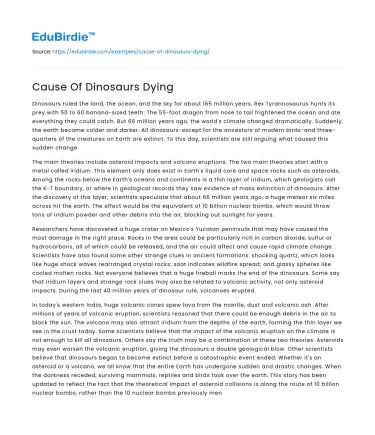Dinosaurs ruled the land, the ocean, and the sky for about 165 million years. Rex Tyrannosaurus hunts its prey with 50 to 60 banana-sized teeth. The 55-foot dragon from nose to tail frightened the ocean and ate everything they could catch. But 66 million years ago, the world's climate changed dramatically. Suddenly, the earth became colder and darker. All dinosaurs-except for the ancestors of modern birds-and three-quarters of the creatures on Earth are extinct. To this day, scientists are still arguing what caused this sudden change.
The main theories include asteroid impacts and volcano eruptions. The two main theories start with a metal called iridium. This element only does exist in Earth's liquid core and space rocks such as asteroids. Among the rocks below the Earth's oceans and continents is a thin layer of iridium, which geologists call the K-T boundary, or where in geological records they saw evidence of mass extinction of dinosaurs. After the discovery of this layer, scientists speculate that about 66 million years ago, a huge meteor six miles across hit the earth. The effect would be the equivalent of 10 billion nuclear bombs, which would throw tons of iridium powder and other debris into the air, blocking out sunlight for years.
Save your time!
We can take care of your essay
- Proper editing and formatting
- Free revision, title page, and bibliography
- Flexible prices and money-back guarantee
Researchers have discovered a huge crater on Mexico's Yucatan peninsula that may have caused the most damage in the right place. Rocks in the area could be particularly rich in carbon dioxide, sulfur or hydrocarbons, all of which could be released, and the air could affect and cause rapid climate change. Scientists have also found some other strange clues in ancient formations: shocking quartz, which looks like huge shock waves rearranged crystal rocks; soot indicates wildfire spread; and glassy spheres like cooled molten rocks. Not everyone believes that a huge fireball marks the end of the dinosaurs. Some say that iridium layers and strange rock clues may also be related to volcanic activity, not only asteroid impacts. During the last 40 million years of dinosaur rule, volcanoes erupted.
In today's western India, huge volcanic cones spew lava from the mantle, dust and volcanic ash. After millions of years of volcanic eruption, scientists reasoned that there could be enough debris in the air to block the sun. The volcano may also attract iridium from the depths of the earth, forming the thin layer we see in the crust today. Some scientists believe that the impact of the volcanic eruption on the climate is not enough to kill all dinosaurs. Others say the truth may be a combination of these two theories. Asteroids may even worsen the volcanic eruption, giving the dinosaurs a double geological blow. Other scientists believe that dinosaurs began to become extinct before a catastrophic event ended. Whether it's an asteroid or a volcano, we all know that the entire Earth has undergone sudden and drastic changes. When the darkness receded, surviving mammals, reptiles and birds took over the earth. This story has been updated to reflect the fact that the theoretical impact of asteroid collisions is along the route of 10 billion nuclear bombs, rather than the 10 nuclear bombs previously mentioned. We regret this mistake.






 Stuck on your essay?
Stuck on your essay?

